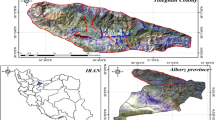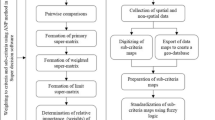Abstract
Appropriate management and planning of suitable areas for the development of ecotourism activities can play an important role in ensuring proper use of the environment. Due to the complexity of nature, applying different tools and models—particularly multi-criteria methods—can be useful in order to achieve these goals. In this study, to indicate suitable areas (land allocation) for ecotourism activities in Taleghan county, weighted linear combination (WLC) using geographical information system (GIS), fuzzy logic, and analytical network process (ANP) were used. To compare the applicability of each of these methods in achieving the goal, the results were compared with the previous model presented by Makhdoum. The results showed that the WLC and ANP methods are more efficient than the Makhdoum model in allocating lands for recreational areas and ecotourism purposes since concomitant use of fuzzy logic and ANP for ranking and weighing the criteria provides us with more flexible and logical conditions. Furthermore, the mentioned method makes it possible to involve ecological, economic, and social criteria simultaneously in the evaluation process in order to allocate land for ecotourism purposes.




Similar content being viewed by others
References
Ananda, J., & Herath, G. (2003). Use of analytic hierarchy process to incorporate stakeholder preferences into regional forest planning. Forest Policy and Economics, 5(1), 13–26.
Anomasiri, W. (2004). Eastern philosophy of ecotourism management model in Mae Son Province. Thailand: Master Thesis, Technology of Environmental Management, Faculty of Graduate Studies, Mahidol University, Bangkok, Thailand.
Babaie-Kafaky, S., Mataji, A., & Ahmadi-Sani, A. (2009). Ecological capability assessment for multiple-use in forest areas using GIS-based multiple criteria decision making approach. American Journal of Environmental Sciences, 5, 714–721.
Balli, A., Monavari, M., Riazi, B., Khorasani, N., & Kheirkhah Zarkesh, M. (2015). A spatial decision support system for ecotourism development in Caspian Hyrcanian mixed forests ecoregion. Boletim de Ciências Geodesicas, sec Artigos, Curitiba, 21(2), 340–353.
Barzekar, G., Aziz, A., Mariapan, M., Ismail, M. H., & Hosseni, S. M. (2011). Delphi technique for generating criteria and indicators in monitoring ecotourism sustainability in Northern forests of Iran: case study on Dohezar and Sehezar Watersheds. Folia Forestalia Polonica Series, 53(2), 130–141.
Boyd, S.W., & Butler, R.W. (1993). Review of the development of ecotourism with respect to identifying criteria for ecotourism for Northern Ontario. Forestry Canada, Ontario Region Sault Set. Marie, ON. Unpublished File Report No. 5. 54p.
Bunruamkaew, K. H., & Murayama, Y. (2012). Site suitability evaluation for ecotourism using GIS & AHP: a case study of Surat Thani Province Thailand. Journal of Procedia Social and Behavioral Sciences, 21, 269–278.
Dashti, S., Monavari, M., Hosseini, M., Riazi, B., & Momeni, M. (2013). Application of GIS, AHP, fuzzy and WLC in island ecotourism development, case study of Qeshm Island, Iran. Life Science Journal, 10(1), 1274–1282.
Dhami, I., Deng, J., Burns, R., & Pierskalla, C. (2014). Identifying and mapping forest-based ecotourism areas in West Virginia—incorporating visitors’ preferences. Tourism Management, 42, 165–176.
Drumm, A., & Moore, A. (2005). Ecotourism development: a manual for conservation planners and managers, volume 1: an introduction to ecotourism planning (2nd ed.). Arlington, VA: The Nature Conservancy.
Eastman, J. R. (2006). IDRISI Andes guide to GIS and image processing. Clark University.
Ghoddousi, J. (2014). Application of MCDM techniques in HSE and environment management. Lecture note (In Persian). IAU. Science and Research Branch, Tehran. College of Environment and Energy.
Hajehforooshina, S. H., Soffianian, A., Salman Mahiny, A., & Fakheran., S. (2011). Multi objective land allocation (MOLA) for zoning Ghamishloo Wildlife Sanctuary in Iran. Journal for Nature Conservation, 19(4), 254–262.
Hosseini, M., Ghafouri, A. M., Mohd Amin, M. S., Tabatabaei, M. R., & Ali Gholami, S. (2012). The landuse change detection in Taleghan catchment. African Journal of Agricultural Research, 7(25), 3665–3672.
Janke, J. R. (2010). Multi-criteria GIS modeling of wind and solar farms in Colorado. Renewable Energy, 35, 2228–2234.
Kangas, J., Kangas, A., Leskinen, P., & Pykalainen, J. (2001). MCDM methods in strategic planning of forestry on state-owned lands in Finland. Journal of Multi-Criteria Decision Analysis, 10, 257–271.
Karimi, A., & Makhdoum, M. (2009). Site selection for development of ecotourism activity in coastal areas of eastern Gilan Province using GIS. Journal of Agricultural Sciences and Natural Resources, 16(1).
Leksakundilok, A. (2004). Ecotourism and community-based ecotourism in the Mekong Region. Working paper series: working paper no.10, The Australian Mekong Resource Centre, University of Sydney, Sydney.
Leksakundilok, A. (2006). Community participation in ecotourism development in Thailand.
Lindberg, K., & Mckercher, B. (1997). Ecotourism: a critical overview. Pacific Tourism Review, 1(1), 65–79.
Mahdavil, A., Niknejad, M., & Karami, O. (2015). A fuzzy multi-criteria decision method for locating ecotourism development. Caspian Journal of Environmental Sciences, 13(3), 221–236.
Makhdom, M. F. (1999). Fundamental of land use planning, publication of Tehran University. Iran: Third edition.
Malczewski, J. (2004). GIS-based land-use suitability analysis: a critical overview. Journal of Progress in Planning, 62.
Mendoza, G., & Prabhu, R. (2006). Participatory modeling and analysis for sustainable forest management: overview of soft system dynamics models and applications. Forest Policy and Economics, 9(2), 179–196.
Mobaraki, O., Abdollahzadeh, M., & Kamelifar, Z. (2014). Site suitability evaluation for ecotourism using GIS and AHP: a case study of Isfahan Townships, Iran. Management Science Letters, 4(8), 1893–1898.
Ok, K. (2005). Multiple criteria activity selection for ecotourism planning in Igneada. Turkish Journal of Agriculture and Forestry, 30, 153–164.
Ozkan, A., & Banar, M. (2010). Refuse derive fuel (RDF) utilization in cement industry by using analytical network process (ANP). Chemical Engineering Transactions, 21, 747–751.
Phua, M., & Minowa, M. (2004). A GIS-based multi-criteria decision making approach to forest conservation planning at a landscape scale: a case study in the Kinabalu Area, Sabah, Malaysia. Landscape and Urban Planning, 71, 207–222.
Piran, H., Maleknia, R., Akbari, H., Soosani, J., & Karami, O. (2013). Site selection for local forest park using analytic hierarchy process and geographic information system (case study: Badreh County). International Research Journal of Applied and Basic Sciences, 6(7), 930–935.
Qadiri, M. M., Baqbani, H. R., & Nourani, H. (2012). The role of rural tourism in rural and urban relations in the county of Taleqan. Spatial Planning, 2(1), 27–48.
Rahmani, O., Rasouli, S.H., Pliehvar, A.A. (2011). Locating optimal capable places for ecotourism development using GIS, case study: Kalaleh County. The First Specialized Congress on Urban Management and Town Councils.
Rezaei-Moghaddam, K., & Karami, E. (2008). A multiple criteria evaluation of sustainable agricultural development models using AHP. Environment Development and Sustainability, 10, 407–426.
Saaty, T. L. (1996). Decision making for leaders: the analytic hierarchy process for decisions in a complex world (3rd ed.). Pittsburgh, PA: RWS Publications.
Saaty, T.L., & Vargas L.G. (2001). Models, methods, concepts and applications of the analytic hierarchy process. International series in operations research and management sciences. Kluwer Academic Publisher, springer, p.333.
Salman Mahini, A., & Gholamalifard, M. (2006). Siting MSW landfills with a weighted linear combination methodology in a GIS environment. International journal of Environmental Science and Technology, 3(4), 435–445.
Thapa, R. B., & Murayama, Y. (2007). Land evaluation for peri-urban agriculture using analytical hierarchy process and geographic information system techniques: a case study of Hanoi. Land Use Policy, 25, 225–239.
Tsaur, S. H., Lin, Y. C., & Lin, J. H. (2006). Evaluating ecotourism sustainability from the integrated perspective of resource, community and tourism. Tourism Management, 27(4), 640–653.
Tulay, C., & Hayran, C. (2006). Land use potential and suitability for areas of arable and garden farming, meadow-pasture and recreation-tourism in Alpagut village, Bolu, Turkey. Journal of Applied Sciences, 6(8), 1641–1651.
Ullah, K.M., Hafiz, R. (2013). Finding suitable locations for ecotourism development in Cox’s Bazar using geographical information system and analytical hierarchy process. Journal of Geocarto International, 1–12.
Ying, X., Guang-Ming, Z., Gui-Qiu, C., Lin, T., Ke-Lin, W., & Dao-You, H. (2007). Combining AHP with GIS in synthetic evaluation of eco-environment quality, a case study of Hunan Province, China. Ecological Modeling, 209, 97–109.
Yuksel, I., & Dagdeviren, M. (2007). Using the analytic network process ANP in a SWOT analysis—a case study for a textile firm. Information Sciences, 177, 3364–3382.
Zarifian, S., Rostami, J., & Alavi, A. (2013). Site-selection of optimal sites for bird watching to ecotourism and hospitality development in International Qurigol Wetland. Journal of Humanities and Social Science, 12, 30–36.
Author information
Authors and Affiliations
Corresponding author
Rights and permissions
About this article
Cite this article
Aliani, H., Kafaky, S.B., Saffari, A. et al. Determining an appropriate method for the purpose of land allocation for ecotourism development (case study: Taleghan County, Iran). Environ Monit Assess 188, 651 (2016). https://doi.org/10.1007/s10661-016-5651-2
Received:
Accepted:
Published:
DOI: https://doi.org/10.1007/s10661-016-5651-2




